New Concept Ocean-Bottom Multiphysics (OBMP) Nodes for Reservoir Monitoring
Abstract
1. Introduction
2. MR3D Project
3. 4D Feasibility
3.1. Forward Modelling—MR4D Data
3.2. Inversions for 3D Appraisal and 4D Responses
4. Discussion
5. Conclusions
Author Contributions
Funding
Data Availability Statement
Acknowledgments
Conflicts of Interest
Abbreviations
| CSEM | Controlled-source electromagnetic |
| BML | Below mud line |
| EM | Electromagnetic |
| OBEM | Ocean-bottom electromagnetic |
| OBMP | Ocean-bottom multiphysics |
| VTI | Vertical transverse isotropy |
| RAR | Resistivity anisotropy ratio |
| Rv | Vertical resistivity |
| Rh | Horizontal resistivity |
| ATR | Anomalous transverse resistance |
| OWC | Oil–water contact |
| BFGS | Broyden–Fletcher–Goldfarb–Shannon |
| RMS | Root-mean-square |
References
- Black, N.; Wilson, G.A.; Gribenko, A.V.; Zhdanov, M.S.; Morris, E. 3D inversion of time-lapse CSEM data based on dynamic reservoir simulations of the Harding field, North Sea. In SEG Technical Program Expanded Abstracts 2011; Society of Exploration Geophysicists: San Antonio, TX, USA, 2011; pp. 666–670. [Google Scholar]
- Shantsev, D.V.; Nerland, E.A.; Gelius, L.J. Time-lapse CSEM: How important is survey repeatability? Geophys. J. Int. 2020, 223, 2133–2147. [Google Scholar] [CrossRef]
- Menezes, P.T.; Correa, J.L.; Alvim, L.M.; Viana, A.R.; Sansonowski, R.C. Time-Lapse CSEM Monitoring: Correlating the Anomalous Transverse Resistance with SoPhiH Maps. Energies 2021, 14, 7159. [Google Scholar] [CrossRef]
- Ziolkowski, A.; Parr, R.; Wright, D.; Nockles, V.; Limond, C.; Morris, E.; Linfoot, J. Multi-transient electromagnetic repeatability experiment over the North Sea Harding field. Geophys. Prospect. 2010, 58, 1159–1176. [Google Scholar] [CrossRef]
- Dong, Z.; Zhang, J.; Yang, G.; Cai, Z.; Lu, Y.; Chen, K. Micro-ocean-bottom electromagnetic receiver for controlled-source electromagnetic and magnetotelluric data acquisition. Rev. Sci. Instrum. 2021, 92, 044705. [Google Scholar] [CrossRef] [PubMed]
- Constable, S. Instrumentation for marine magnetotelluric and controlled source electromagnetic sounding. Geophys. Prospect. 2013, 61, 505–532. [Google Scholar] [CrossRef]
- Zerilli, A.; Menezes, P.T.L.; Crepaldi, J.L.; Correa, J.L.; Viana, A.R. Ocean-bottom multiphysics—Path to superior reservoir monitoring. In Proceedings of the SEG/AAPG/SEPM First International Meeting for Applied Geoscience & Energy; OnePetro: Houston, TX, USA, 2021. [Google Scholar] [CrossRef]
- Bunting, T. The Evolution of the OBN Acquisition Solution. In Proceedings of the EAGE Seabed Seismic Today: From Acquisition to Application; European Association of Geoscientists & Engineers: Kosterijland, The Netherlands, 2020; Volume 2020, pp. 1–4. [Google Scholar]
- Walker*, C.; McIntosh, S. Autonomous Nodes–The Future of Marine Seismic Data Acquisition? In Proceedings of the 12th International Congress of the Brazilian Geophysical Society & EXPOGEF, Rio de Janeiro, Brazil, 15–18 August 2011; Society of Exploration Geophysicists and Brazilian Geophysical Society: Riode de Janeiro, RJ, Brazil, 2011; pp. 1–6. [Google Scholar]
- Key, K. 1D inversion of multicomponent, multifrequency marine CSEM data: Methodology and synthetic studies for resolving thin resistive layers. Geophysics 2009, 74, F9–F20. [Google Scholar] [CrossRef]
- Constable, S.; Orange, A.; Myer, D. Marine controlled-source electromagnetic of the Scarborough gas field—Part 3: Multicomponent 2D magnetotelluric/controlled-source electromagnetic inversions. Geophysics 2019, 84, B387–B401. [Google Scholar] [CrossRef]
- Tharimela, R.; Augustin, A.; Ketzer, M.; Cupertino, J.; Miller, D.; Viana, A.; Senger, K. 3D controlled-source electromagnetic imaging of gas hydrates: Insights from the Pelotas Basin offshore Brazil. Interpretation 2019, 7, SH111–SH131. [Google Scholar] [CrossRef]
- Menezes, P.T.L.; Correa, J.L.; Menor, E.N.; Ferreira, S.M.; Zerilli, A.; Labruzzo, T. Ocean-bottom multiphysics for reservoir monitoring—Increasing the value of information. In Proceedings of the Second International Meeting for Applied Geoscience & Energy, Houston, TX, USA, 28 August–1 September 2022; pp. 692–696. [Google Scholar] [CrossRef]
- Correa, J.L.; Menezes, P.T. Marlim R3D: A realistic model for controlled-source electromagnetic simulations—Phase 2: The controlled-source electromagnetic data set. Geophysics 2019, 84, E293–E299. [Google Scholar] [CrossRef]
- Carvalho, B.R.; Menezes, P.T.L. Marlim R3D: A realistic model for CSEM simulations-phase I: Model building. Braz. J. Geol. 2017, 47, 633–644. [Google Scholar] [CrossRef]
- Nascimento, T.M.; Menezes, P.T.; Braga, I.L. High-resolution acoustic impedance inversion to characterize turbidites at Marlim Field, Campos Basin, Brazil. Interpretation 2014, 2, T143–T153. [Google Scholar] [CrossRef]
- Shecaira, F.S.; Daher, J.S.; Gomes, A.C.A.; Capeleiro Pinto, A.C.; Filoco, P.R.; Gomes, J.A.T.; Freitas, L.C.S.; Balthar, S. Injeção de Água no Campo de Marlim—Uma Abordagem Integrada para o Gerenciamento de Reservatórios. In Proceedings of the Rio Oil & Gas Expo and Conference; Brazilian Petroleum Institute—IBP: Rio de Janeiro, RJ, Brazil, 2000; pp. 1–9. [Google Scholar]
- Peres, W.E. Shelf-fed turbidite system model and its application to the Oligocene deposits of the Campos Basin, Brazil. AAPG Bull. 1993, 77, 81–101. [Google Scholar]
- Lourenço, J.; Menezes, P.T.L.; Barbosa, V.C.F. Connecting onshore-offshore Campos Basin structures: Interpretation of high-resolution airborne magnetic data. Interpretation 2014, 2, SJ35–SJ45. [Google Scholar] [CrossRef]
- Cobbold, P.R.; Meisling, K.E.; Mount, V.S. Reactivation of an obliquely rifted margin, Campos and Santos basins, southeastern Brazil. AAPG Bull. 2001, 85, 1925–1944. [Google Scholar] [CrossRef]
- Guardado, L.R.; Spadini, A.R.; Brandão, J.S.L.; Mello, M.R. Petroleum System of the Campos Basin, Brazil. In Petroleum systems of South Atlantic margins: AAPG Memoir 73; Mello, M.R., Katz, B.J., Eds.; AAPG: Tulsa, OK, USA, 2000; Chapter 22; pp. 317–324. [Google Scholar]
- Mutti, E.; Cunha, R.S.; Bulhoes, E.; Arienti, L.M.; Viana, A.R. Contourites and turbidites of the Brazilian marginal basins. In Proceedings of the AAPG Annual Convention & Exhibition, Houston, TX, USA, 6–9 April 2014. [Google Scholar]
- Maaø, F.A. Fast finite-difference time-domain modeling for marine-subsurface electromagnetic problems. Geophysics 2007, 72, A19–A23. [Google Scholar] [CrossRef]
- Mittet, R.; Morten, J.P. Detection and imaging sensitivity of the marine CSEM method. Geophysics 2012, 77, E411–E425. [Google Scholar] [CrossRef]
- Zach, J.; Bjørke, A.; Støren, T.; Maaø, F. 3D inversion of marine CSEM data using a fast finite-difference time-domain forward code and approximate Hessian-based optimization. In SEG Technical Program Expanded Abstracts 2008; Society of Exploration Geophysicists: Las Vegas, NV, USA, 2008; pp. 614–618. [Google Scholar]
- Lyrio, J.C.S.O.; Menezes, P.T.L.; Correa, J.L.; Viana, A.R. Multiphysics anomaly map: A new data fusion workflow for geophysical interpretation. Interpretation 2020, 8, B35–B43. [Google Scholar] [CrossRef]
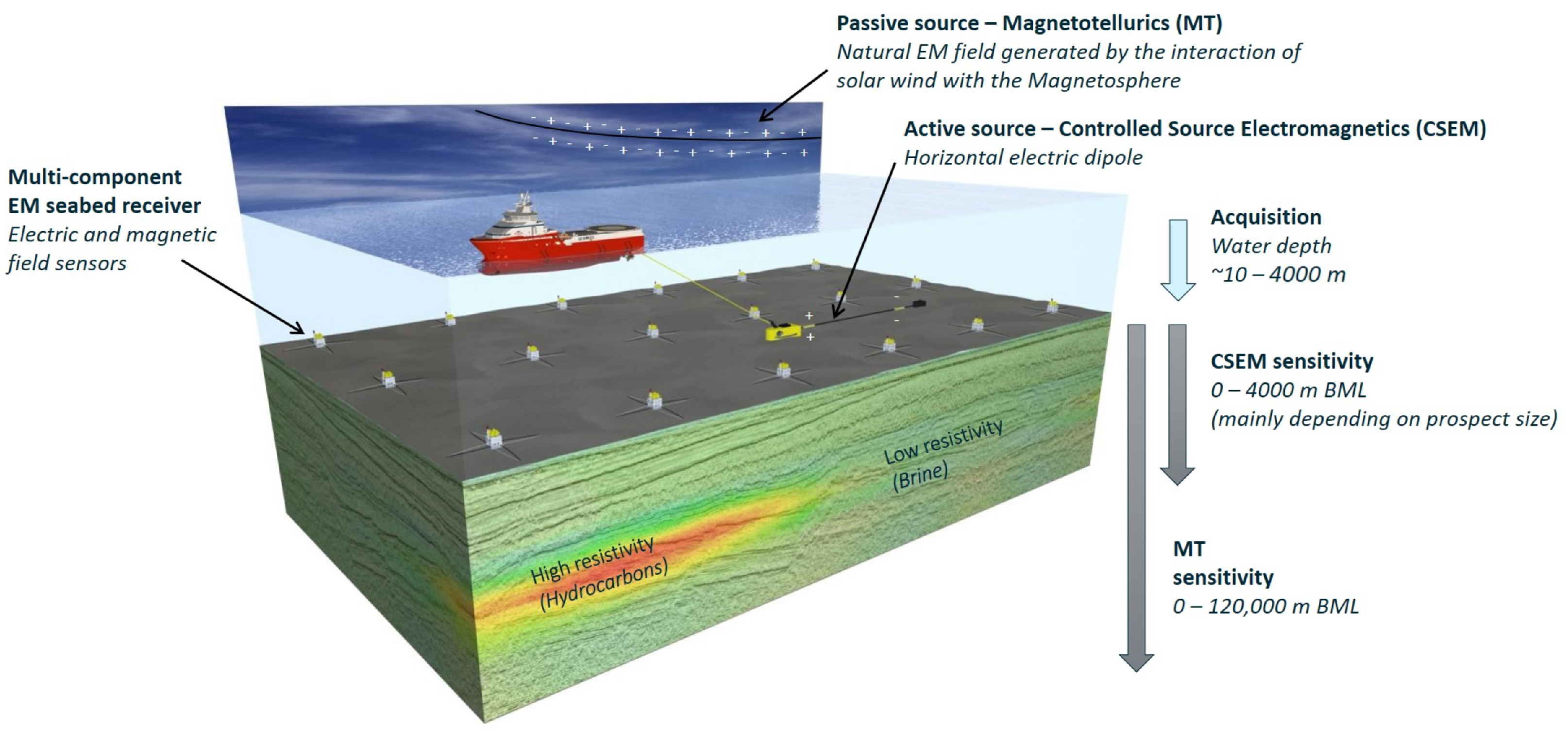
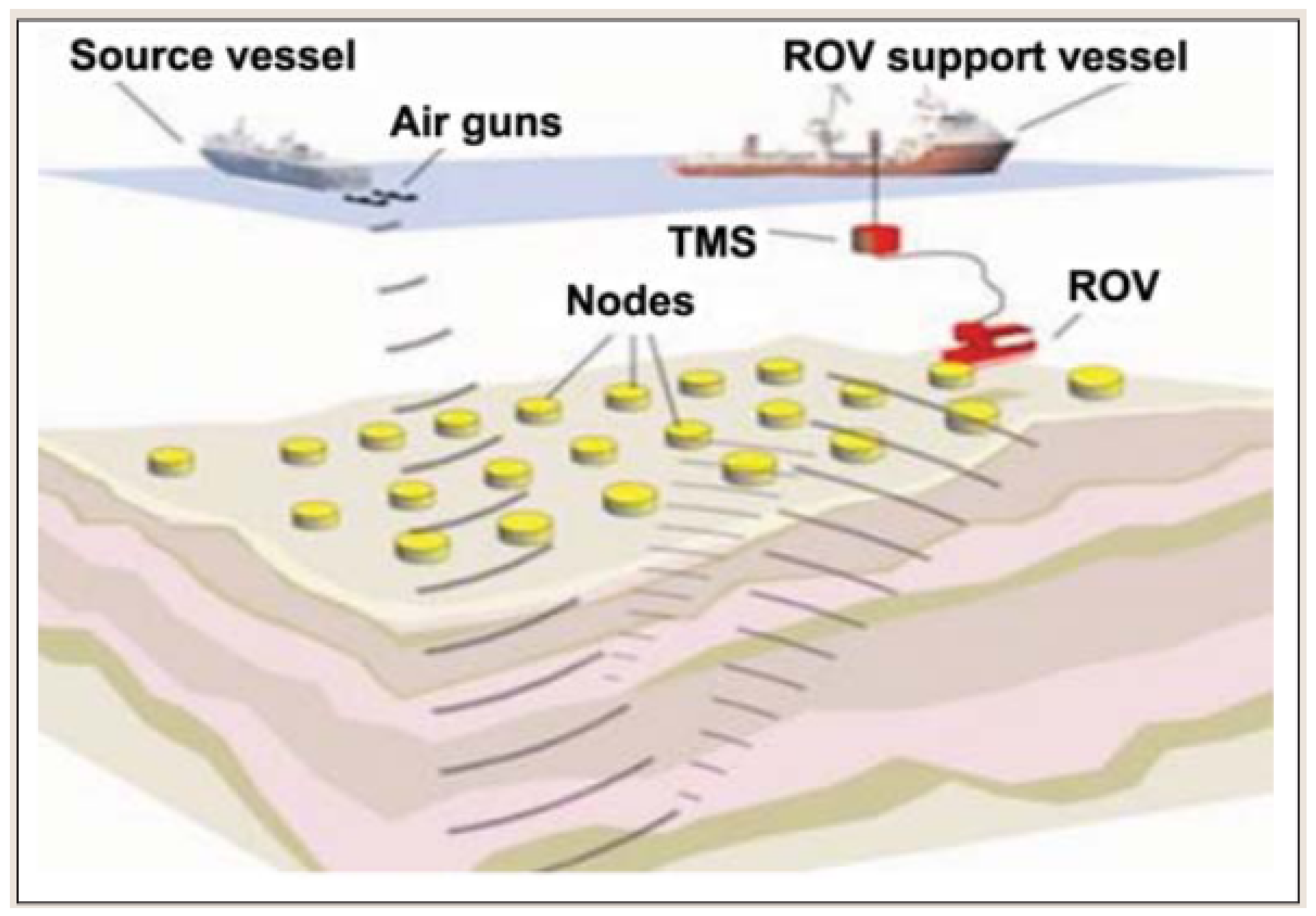

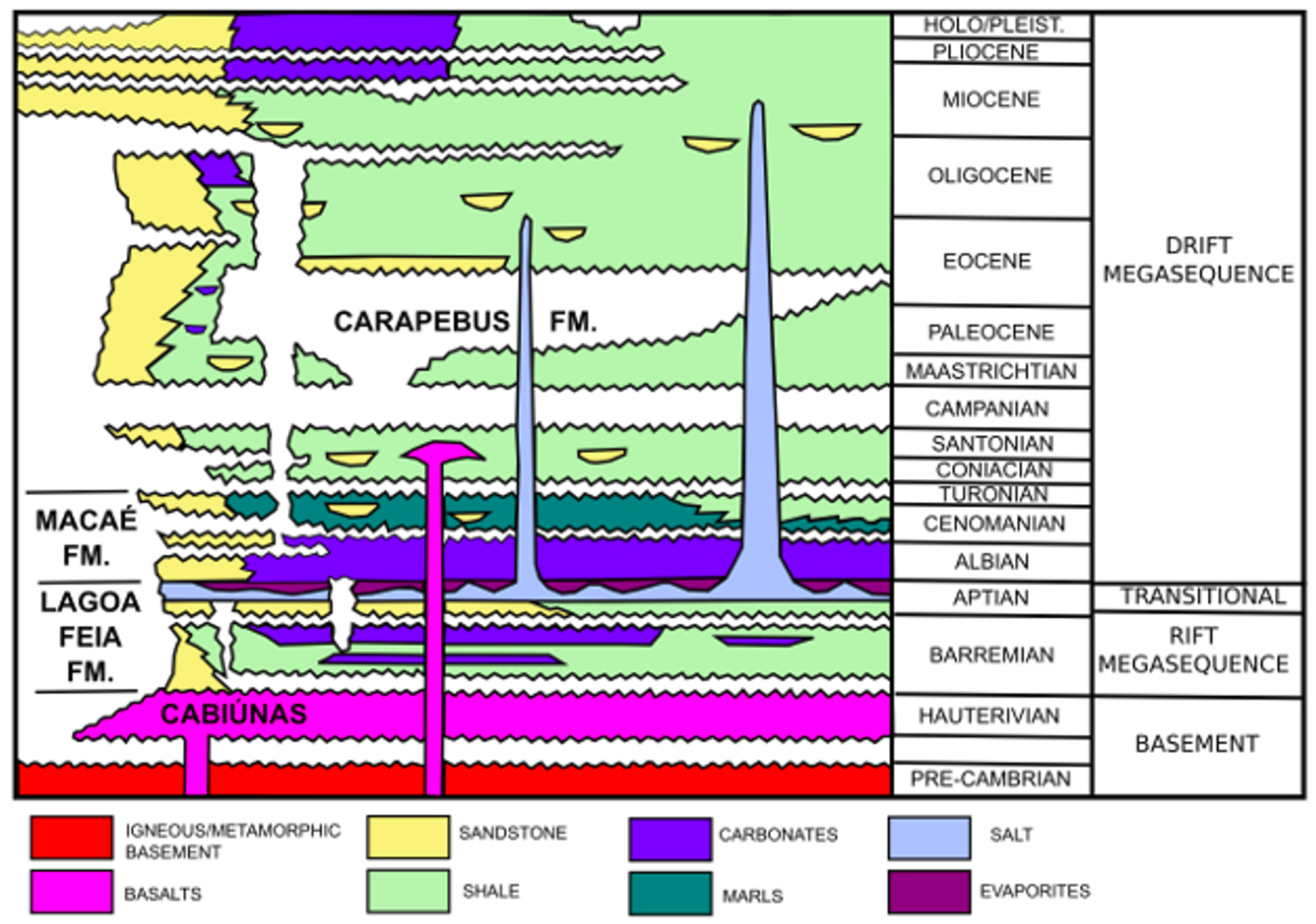
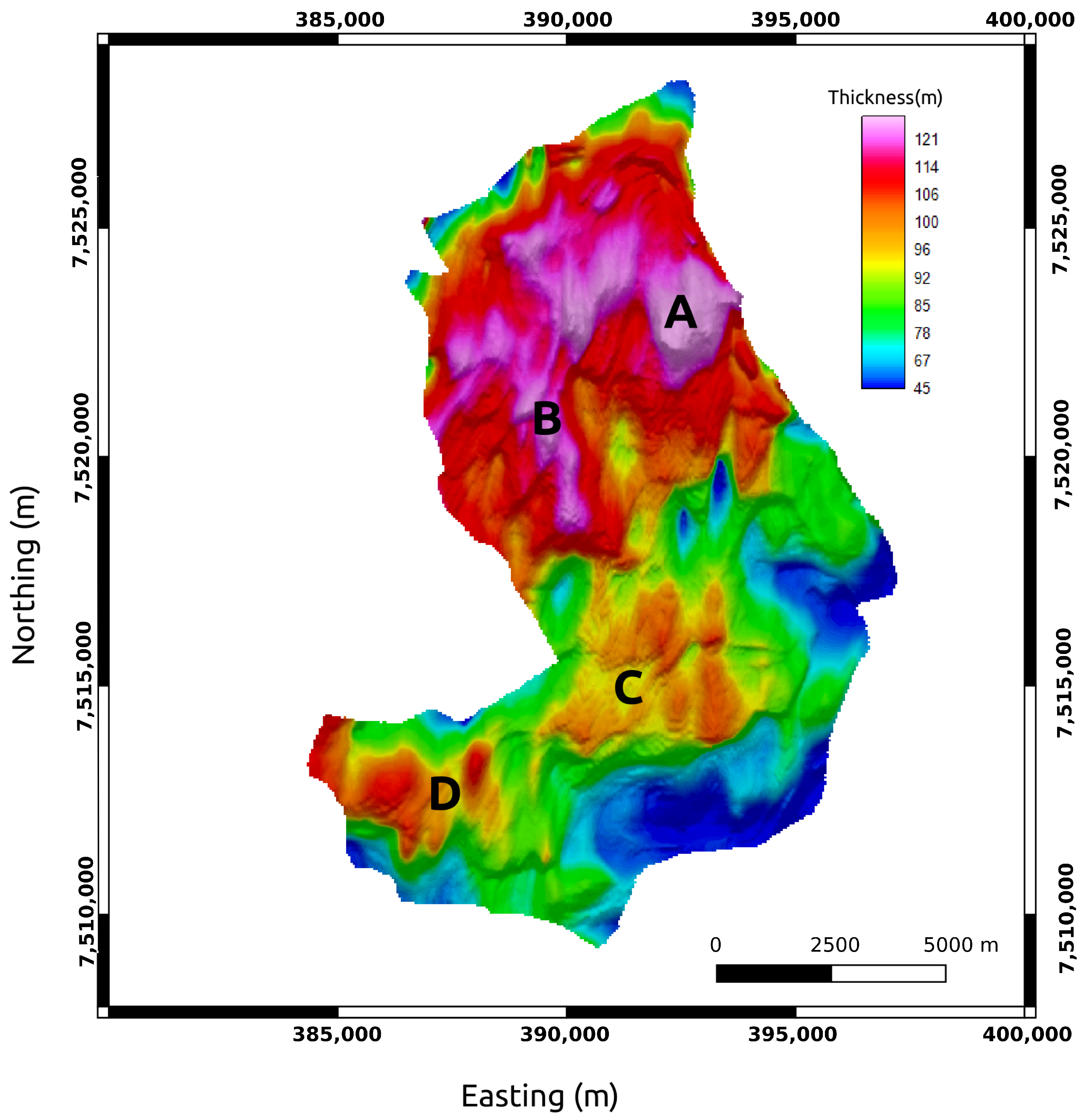
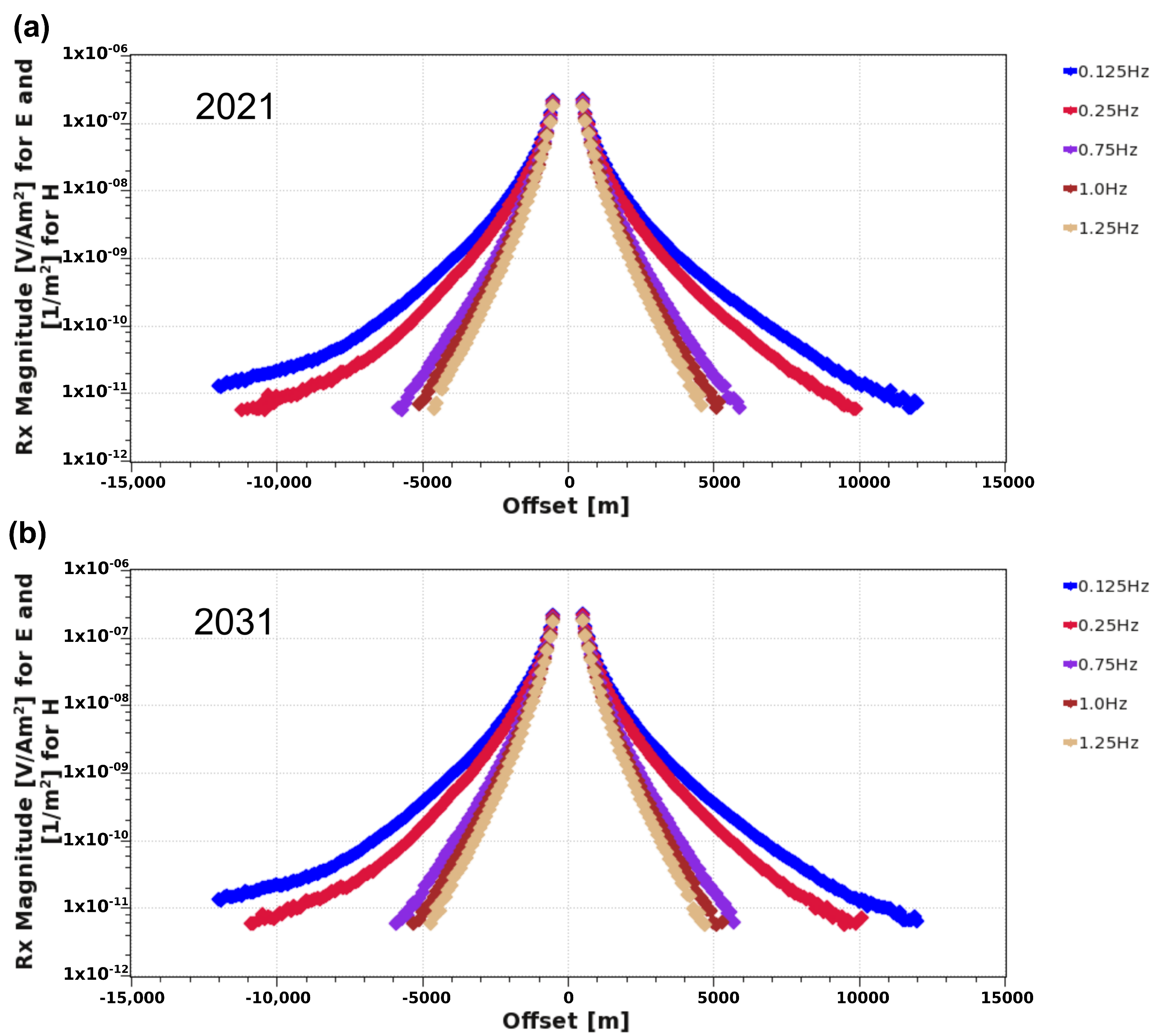
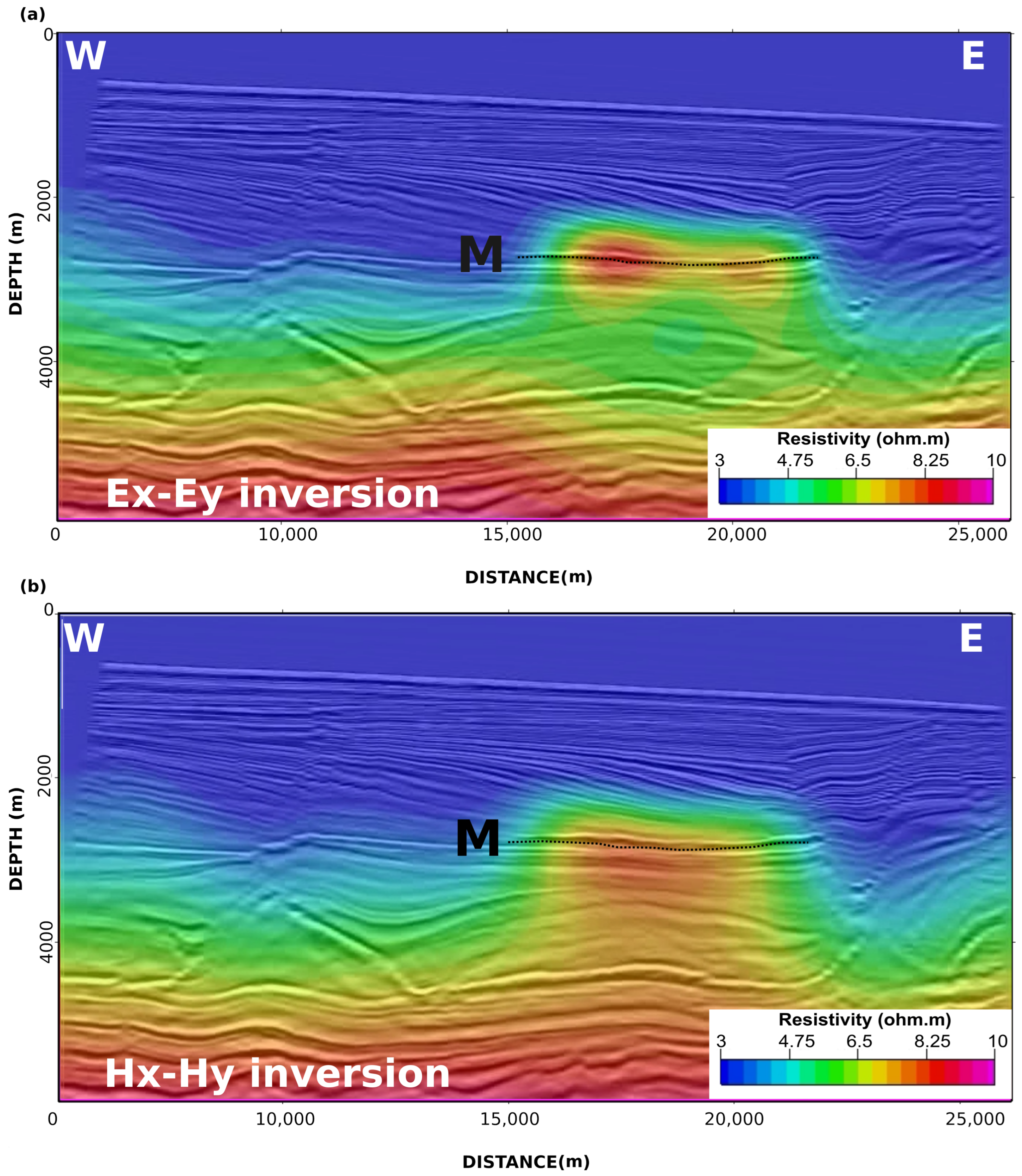

| Mesh Parameters | Dimensions |
|---|---|
| Cell size - X | 200 m |
| Cell size - Y | 200 m |
| Cell size - Z | 50 m |
| Number of cells - X | 220 |
| Number of cells - Y | 195 |
| Number of cells - Z | 110 |
| Total number of cells | 8,910,000.00 |
Disclaimer/Publisher’s Note: The statements, opinions and data contained in all publications are solely those of the individual author(s) and contributor(s) and not of MDPI and/or the editor(s). MDPI and/or the editor(s) disclaim responsibility for any injury to people or property resulting from any ideas, methods, instructions or products referred to in the content. |
© 2023 by the authors. Licensee MDPI, Basel, Switzerland. This article is an open access article distributed under the terms and conditions of the Creative Commons Attribution (CC BY) license (https://creativecommons.org/licenses/by/4.0/).
Share and Cite
Menezes, P.T.L.; Zerilli, A.; Correa, J.L.; Menor, E.N.; Ferreira, S.M.; Labruzzo, T. New Concept Ocean-Bottom Multiphysics (OBMP) Nodes for Reservoir Monitoring. Minerals 2023, 13, 602. https://doi.org/10.3390/min13050602
Menezes PTL, Zerilli A, Correa JL, Menor EN, Ferreira SM, Labruzzo T. New Concept Ocean-Bottom Multiphysics (OBMP) Nodes for Reservoir Monitoring. Minerals. 2023; 13(5):602. https://doi.org/10.3390/min13050602
Chicago/Turabian StyleMenezes, Paulo T. L., Andrea Zerilli, Jorlivan L. Correa, Everton N. Menor, Sergio M. Ferreira, and Tiziano Labruzzo. 2023. "New Concept Ocean-Bottom Multiphysics (OBMP) Nodes for Reservoir Monitoring" Minerals 13, no. 5: 602. https://doi.org/10.3390/min13050602
APA StyleMenezes, P. T. L., Zerilli, A., Correa, J. L., Menor, E. N., Ferreira, S. M., & Labruzzo, T. (2023). New Concept Ocean-Bottom Multiphysics (OBMP) Nodes for Reservoir Monitoring. Minerals, 13(5), 602. https://doi.org/10.3390/min13050602







